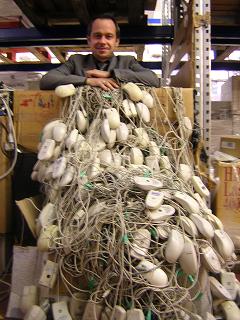Computer Aid: New life for old IT

The organisation recently passed the 40,000 mark, equivalent to over £2m worth of computers on the basis that Computer Aid values each one at £50. The value to the recipients however, which can be anything from schools to local not-for-profit projects, is much higher.
Chief executive Tony Roberts is the man behind the Computer Aid International venture. His inspiration for setting up the organisation came from witnessing the need for computers in developing nations first hand while working with an aid organisation in Southern Africa during the mid-90s.
"I saw organisations who wanted to bring in computers, but computers then cost a lot of money, and the people could not look forward to a time when they might be able to afford them," says Roberts. "At the same time, we saw that back in the UK the market would become saturated, but this really came home to us when we were preparing to send a volunteer to Nicaragua to help develop a large database application."
Roberts explains that the volunteer's local newspaper ran a story that included a plea to readers for computers he could take with him. The story generated offers of 320 PCs. "So we spun off Computer Aid as a separate charity", says Roberts. "We ran it with no full-time paid staff until Y2K, when CIOs started kicking out their 486 PCs. Since then we've grown by 50 to 100 percent every year."
Donations are expected to rise again this year as the WEEE directive comes into force, which effectively outlaws landfilling of old PCs. "We estimated that 2 million PCs are landfilled every year in the UK alone," says Robert. "Nigeria's schools alone could absorb those PCs. There is a huge potential supply and demand. The big job now is to raise the money it costs to refurbish them."
You can donate old PCs, sign up for the Digital Divide newsletter or donate cash to support Computer Aid's refurbishing efforts through BridgeTheDigitalDivide.com, which is run in conjunction with ZDNet UK's parent company CNET Networks UK.
Everything is considered for refurbishing, from routers and printers to PCs and servers. ZDNet UK went along to Computer Aid's facility on London's Holloway Road to see how it's done.

The mouse that roared: Chief executive Tony Roberts has seen Computer Aid grow by 50 to 100 percent every year since its inception.
Refurbishing: Blancco software is used to wipe disks to government standards, even though and this uses all components, they are subsequently retested. Over 1,500 PCs pass through this workshop every month.
Not just PCs: Computer Aid also ships printers, servers, routers - pretty much anything that will help an organisation build its IT infrastructure. Unserviceable kit is sent to be recycled - none of it ends up in landfills.
Quality kit: Occasionally Computer Aid is asked to clear out offices of brand new equipment, and some organisations end up with some pretty nice kit.
Waiting to go: Each PC costs £39 to refurbish and £11 to ship. Aside from taking donated equipment, Computer Aid also accepts cash donations to help cover these costs.
Ready to go: One palette of a shipment destined for Uganda. Every computer sent has to fit into these boxes, which allows the palettes to be stacked four by five into containers.